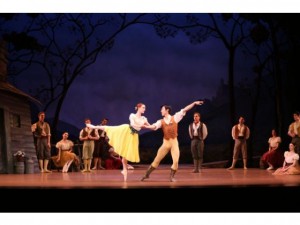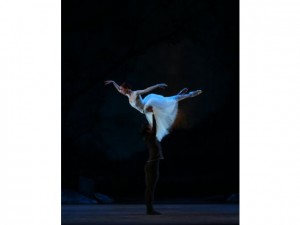On Friday night, opening its first U.S. tour in decades, Royal Ballet New Zealand performed on L.A.’s premium dance stage, the Los Angeles Music Center, presenting the U.S. premiere of a new “Giselle,” the company’s first full-length creation under the guidance of artistic director Ethan Stiefel, who took the helm of the company in 2011. Here follows a version of my review that ran in the Orange County Register.
When a member of dance royalty like Stiefel (beloved American Ballet Theater principal, star of Nicholas Hytner’s two “Center Stage” films) assumes artistic control of small company (Royal New Zealand Ballet), it’s easy to anticipate some kind of direct energy transfer. His exuberance will become the company’s exuberance, particularly if the company is performing “Giselle,” the story of a super-charged peasant girl on a tragic romantic trajectory.
Yet where one expected sparks, there was – surprisingly – something much more substantial, dark and complex at the L.A. Music Center on Friday. And quite the rare event. Though the company is touring four cities in the United States this month, “Giselle” will play only in California. Later U.S. tour stops in Minneapolis and New York will feature a mixed-repertory bill featuring such contemporary choreographers as Benjamin Millepied and Javier De Frutos.
Co-choreographed by Stiefel and Johan Kobborg (after Marius Petipa), with live orchestra conducted by RNZB music director Nigel Gaynor, this was a conservative yet distinctive version of the classic two-act ballet. The technical demands were full-throttle, and it was great to see how many New Zealand- and Australian-raised dancers populated the company with beautiful lines and easy presences.
Streamlined and imaginative, RZNB’s new “Giselle” gently revealed smart, near-perfect conception.
A simple scrim featured an animated tree festooned with small hearts where budding leaves would be. As the Adolphe Adam score began with a crash, the hearts let loose from the branches and the scrim revealed the tree’s stark, spreading root system.
Over time, this dichotomy between full and empty bouquets accumulated deeper and deeper meaning: from the Act I scene of courting lovers plucking daisy petals to the satisfying inclusion of a wedding couple (in place of the simple peasant-couple interlude), with echoes now from white dresses and a bridal bouquet.
Also used as a striking recurring image was a mad, hulking caped figure seen through the scrim – assumedly this is Giselle’s duplicitous suitor Albrecht, many years later, now almost post-human himself.
Choreographers Stiefel and Kobborg both earned career distinctions dancing the crucial role of Albrecht, and their meticulous choreography and acting arc for this tormented character was gloriously evoked by the opening night lead, longtime RNZB dancer Qi Huan.
Yet what of Giselle herself? How would the troupe’s honored guest artist, stately ABT principal Gillian Murphy (also Stiefel’s fiancée), achieve a quality of giddy exuberance that she’s never really possessed? Dancing with ABT, Murphy is always cast as Myrtha, the elegant, resolute Queen of the Wilis. Would this end up feeling like some kind of prequel, working backwards from her powerful anger?
In a very daring move, Murphy’s Giselle began coolly, carefully and totally giggle-free. Her radiance was quiet; her energy almost meek. With her intelligent, watchful expression and her fiery red hair sleeked down tightly, she evoked one of the dreamy and inward Brontë sisters, a brilliant echo. (They all published in the decade that Giselle debuted, the 1840s, and all three sisters died terribly young and unfinished.) Thus explains the haunting recurrence of Albrecht looking so like the tormented Heathcliff.
Stiefel’s strategy here is risky and nuanced, and the lead couple commit entirely to the studied, slow-burn pacing, which paid off handsomely in Act II when Giselle’s integral coolness becomes her strength among the Wilis. (The beautifully synchronized pair also worked together on a feature film of this “Giselle,” directed by New Zealand director Toa Fraser, which was released in 2012 and has yet to come to the U.S.)
Will this quality of cool strength emerge from younger RNZB dancers with less partnership experience? We’ll see: A second Giselle/Albrecht pairing, Lucy Green and Kohei Iwamoto, are slated to perform at the matinees here.
The only distraction, aside from two fleeting, messy-lined moments from soloists, was the disarray in Natalia Stewart’s costume design. Traditional Rhineland villagers are not visited by royalty but by gentry in Victorian-era riding costumes: bustling dresses and morning coats with top hats. And on many of the smaller corps dancers, the Wilis’ updated off-the-shoulder dresses needed serious altering.
Yet these are minor faults. What lingers are the cascade and range of exceptional physical gestures, from the corps’ turns and pointe work to Huan’s furiously rising sets of beat jumps, or simply the way Murphy, held in a fast swoon, finds a perfect overhead fifth position for her arms.
Update: Within a month of this performance, Ethan Stiefel resigned from his position at Royal New Zealand Ballet, effective Sept 1 2014. His successor, Italian ballet dancer/choreographer Francesco Ventriglia, last with MaggioDanza, a contemporary ballet company in Florence, takes the reigns in November.

